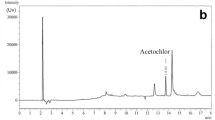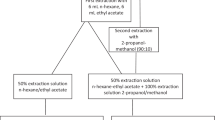Abstract
The purpose of this paper was to highlight potential exposure in indoor air to phosphorus flame retardants (PFRs) due to their use in upholstered furniture. For that, an analytical method of PFRs by headspace coupled to solid-phase micro-extraction (HS–SPME) was developed on cushioning foams in order to determine the PFRs’ volatile fraction in the material. Tests on model foams proved the feasibility of the method. The average repeatability (RSD) is 6.3 % and the limits of detection range from 0.33 to 1.29 μg g−1 of foam, depending on the PFRs. Results showed that some PFRs can actually be emitted in air, leading to a potential risk of exposure by inhalation. The volatile fraction can be high (up to 98 % of the total PFRs amount) and depends on the physicochemical properties of flame retardants, on the textural characteristics of the materials and on the temperature. The methodology developed for cushioning foams could be further applied to other types of materials and can be used to rate them according to their potential releases of phosphorus flame retardants.





Similar content being viewed by others
References
Ali, N., Dirtu, A. C., Van den Eede, N., Goosey, E., Harrad, S., Neels, H., et al. (2012). Occurrence of alternative flame retardants in indoor dust from New Zealand: indoor sources and human exposure assessment. Chemosphere, 88(11), 1276–1282. doi:10.1016/j.chemosphere.2012.03.100.
Altwaiq, A. M., Wolf, M., & van Eldik, R. (2003). Extraction of brominated flame retardants from polymeric waste material using different solvents and supercritical carbon dioxide. Analytica Chimica Acta, 491(1), 111–123. doi:10.1016/S0003-2670(03)00785-2.
ANSES (2013). Risques liés à l’exposition aux retardateurs de flamme des meubles rembourrés. https://www.anses.fr/fr/system/files/SUBCHIM2011sa0132Ra-01.pdf. Accessed 5 Aug 2015.
ANSES (2015). Evaluation des risques liés à l’exposition aux retardateurs de flamme dans les meubles rembourrés : Partie 2—Evaluation des effets sur la santé et sur l’environnement, et estimation qualitative du rapport bénéfices/risques. https://www.anses.fr/fr/system/files/CONSO2011sa0132Ra-02.pdf. Accessed 20 Oct 2015.
Aragón, M., Borrull, F., & Marcé, R. M. (2013). Thermal desorption-gas chromatography-mass spectrometry method to determine phthalate and organophosphate esters from air samples. Journal of Chromatography. A, 1303, 76–82. doi:10.1016/j.chroma.2013.06.025.
Beth-Hubner, M., & Devilliers, B. (1999). Toxicological evaluation and classification of the genotoxic, carcinotoxic, reprotoxic and sensitising potential of the tris(2-chloroethyl)phosphate. International Archives of Occupational and Environmental Health, 72(11), 17–23.
Björklund, J., Isetun, S., & Nilsson, U. (2004). Selective determination of organophosphate flame retardants and plasticizers in indoor air by gas chromatography, positive-ion chemical ionization and collision-induced dissociation mass spectrometry. Rapid communications in mass spectrometry: RCM, 18(24), 3079–3083. doi:10.1002/rcm.1721.
Carlsson, H., Nilsson, U., Becker, G., & Östman, C. (1997). Organophosphate Ester flame retardants and plasticizers in the indoor environment: analytical methodology and occurrence. Environmental Science & Technology, 31(10), 2931–2936. doi:10.1021/es970123s.
Chivas, C., Guillaume, E., & Sainrat, A. (2007). Etude sur les effets de l’ignifugation de certains meubles rembourrés dans le cadre d’un projet de réglementation relative à la sécurité incendie : Partie 1—Etat de l’art. Document LNE, Projet R&D 27EAF6707. https://www.lne.fr/fr/actualites/pdf/meubles-rembourres-toxicite-ignifugeants-Etat-de-l-art.pdf. Accessed 8 Aug 2015.
Covaci, A., Gerecke, A. C., Law, R. J., Voorspoels, S., Kohler, M., Heeb, N. V., et al. (2006). Hexabromocyclododecanes (HBCDs) in the environment and humans: a review. Environmental Science and Technology, 40(12), 3679–3688. doi:10.1021/es0602492.
Dishaw, L. V., Powers, C. M., Ryde, I. T., Roberts, S. C., Seidler, F. J., Slotkin, T. A., & Stapleton, H. M. (2011). Is the PentaBDE replacement, tris (1,3-dichloro-2-propyl) phosphate (TDCPP), a developmental neurotoxicant? Studies in PC12 cells. Toxicology and Applied Pharmacology, 256(3), 281–289. doi:10.1016/j.taap.2011.01.005.
Ellis, J., Shah, M., Kubachka, K. M., & Caruso, J. A. (2007). Determination of organophosphorus fire retardants and plasticizers in wastewater samples using MAE-SPME with GC-ICPMS and GC-TOFMS detection. Journal of Environmental Monitoring, 9(12), 1329–1336. doi:10.1039/b710667j.
European Chemicals Agency (2016). Community Rolling Action Plan (CoRAP)—Substance evaluation. https://echa.europa.eu/documents/10162/13628/corap_list_2016-2018_en.pdf. Accessed 12 Apr 2016.
European flame retardants association (2015). Utilisation de retardateurs de flamme. http://www.cefic-efra.com/index.php/fr/furniture-a-textile-fr/use-of-flame-retardants-fr-fr. Accessed 8 Aug 2015.
Félix, J. S., Domeño, C., & Nerín, C. (2013). Characterization of wood plastic composites made from landfill-derived plastic and sawdust: volatile compounds and olfactometric analysis. Waste Management, 33(3), 645–655. doi:10.1016/j.wasman.2012.11.005.
French Minister of Housing and Sustainable Habitat (2015). Coup d’envoi de la campagne nationale de prévention contre les incendies domestiques. Coup d?envoi de la campagne nationale de pr?vention contre les incendies domestiques. Accessed 5 Aug 2015.
Gröning, M., & Hakkarainen, M. (2001). Headspace solid-phase microextraction—a tool for new insights into the long-term thermo-oxidation mechanism of polyamide 6.6. Journal of Chromatography A, 932(1–2), 1–11. doi:10.1016/S0021-9673(01)01230-4.
Hartmann, P. C., Bürgi, D., & Giger, W. (2004). Organophosphate flame retardants and plasticizers in indoor air. Chemosphere, 57(8), 781–787. doi:10.1016/j.chemosphere.2004.08.051.
Isetun, S., & Nilsson, U. (2005). Dynamic field sampling of airborne organophosphate triesters using solid-phase microextraction under equilibrium and non-equilibrium conditions. The Analyst, 130(1), 94–98. doi:10.1039/b410597d.
Isetun, S., Nilsson, U., & Colmsjö, A. (2004a). Evaluation of solid-phase microextraction with PDMS for air sampling of gaseous organophosphate flame-retardants and plasticizers. Analytical and Bioanalytical Chemistry, 380(2), 319–324. doi:10.1007/s00216-004-2760-5.
Isetun, S., Nilsson, U., Colmsjö, A., & Johansson, R. (2004b). Air sampling of organophosphate triesters using SPME under non-equilibrium conditions. Analytical and Bioanalytical Chemistry, 378(7), 1847–1853. doi:10.1007/s00216-003-2489-6.
ISO 16000-11 (2006). Indoor air—Part 11: Determination of the emission of volatile organic compounds from building products and furnishing—sampling, storage of samples and preparation of test specimens. International Organization for Standardization.
ISO 16000-25 (2011). Indoor air—Part 25: Determination of the emission of semi-volatile organic compounds by building products—micro-chamber method. International Organization for Standardization.
ISO 16000-9 (2006). Indoor air—Part 9: Determination of the emission of volatile organic compounds from building products and furnishing—emission test chamber method. International Organization for Standardization.
ISO 4892-2 (2013). Plastics—methods of exposure to laboratory light sources—Part 2: Xenon-arc lamps. International Organization for Standardization.
Katsumata, H., Murakami, S., Kato, S., Hoshino, K., & Ataka, Y. (2008). Measurement of semi-volatile organic compounds emitted from various types of indoor materials by thermal desorption test chamber method. Building and Environment, 43(3), 378–383. doi:10.1016/j.buildenv.2006.03.027.
Kemmlein, S., Hahn, O., & Jann, O. (2003). Emissions of organophosphate and brominated flame retardants from selected consumer products and building materials. Atmospheric Environment, 37(39–40), 5485–5493. doi:10.1016/j.atmosenv.2003.09.025.
Kotowska, U., Żalikowski, M., & Isidorov, V. A. (2012). HS-SPME/GC–MS analysis of volatile and semi-volatile organic compounds emitted from municipal sewage sludge. Environmental Monitoring and Assessment, 184(5), 2893–2907. doi:10.1007/s10661-011-2158-8.
Kwon, K.-D., Jo, W.-K., Lim, H.-J., & Jeong, W.-S. (2007). Characterization of emissions composition for selected household products available in Korea. Journal of Hazardous Materials, 148(1–2), 192–198. doi:10.1016/j.jhazmat.2007.02.025.
Lattuati-Derieux, A., Bonnassies-Termes, S., & Lavédrine, B. (2006). Characterisation of compounds emitted during natural and artificial ageing of a book. Use of headspace-solid-phase microextraction/gas chromatography/mass spectrometry. Journal of Cultural Heritage, 7(2), 123–133. doi:10.1016/j.culher.2006.02.004.
Little, J. C., Weschler, C. J., Nazaroff, W. W., Liu, Z., & Cohen Hubal, E. A. (2012). Rapid methods to estimate potential exposure to semivolatile organic compounds in the indoor environment. Environmental Science & Technology, 46(20), 11171–11178. doi:10.1021/es301088a.
Marklund, A., Andersson, B., & Haglund, P. (2003). Screening of organophosphorus compounds and their distribution in various indoor environments. Chemosphere, 53(9), 1137–1146. doi:10.1016/S0045-6535(03)00666-0.
Marklund, A., Andersson, B., & Haglund, P. (2005). Organophosphorus flame retardants and plasticizers in air from various indoor environments. Journal of environmental monitoring: JEM, 7(8), 814–819. doi:10.1039/b505587c.
NF EN 1021-1 (2014). Furniture—assessment of the ignitability of upholstered furniture—Part 1: Ignition source smouldering cigarette. AFNOR.
Official journal of the European Union (2008). Regulation (EC) No 1272/2008 of the European Parliament and of the Council of 16 December 2008 on classification, labelling and packaging of substances and mixtures.
Saboori, A. M., Lang, D. M., & Newcombe, D. S. (1991). Structural requirements for the inhibition of human monocyte carboxylesterase by organophosphorus compounds. Chemico-Biological Interactions. doi:10.1016/0009-2797(91)90092-L.
Salthammer, T., & Bahadir, M. (2009). Occurrence, dynamics and reactions of organic pollutants in the indoor environment. CLEAN - Soil, Air, Water, 37(6), 417–435. doi:10.1002/clen.200900015.
Sato, T., Watanabe, K., Nagase, H., Kito, H., Niikawa, M., & Yoshioka, Y. (1997). Investigation of the hemolytic effects of various organophosphoric acid triesters (OPEs) and their structurel activity relationship. Toxicological & Environmental Chemistry, 59, 305–313. doi:10.1080/02772249709358444.
Shah, M., Meija, J., Cabovska, B., & Caruso, J. A. (2006). Determination of phosphoric acid triesters in human plasma using solid-phase microextraction and gas chromatography coupled to inductively coupled plasma mass spectrometry. Journal of Chromatography A, 1103(2), 329–336. doi:10.1016/j.chroma.2005.11.042.
Staaf, T., & Ostman, C. (2005a). Organophosphate triesters in indoor environments. Journal of environmental monitoring: JEM, 7(9), 883–887. doi:10.1039/b506631j.
Staaf, T., & Ostman, C. (2005b). Indoor air sampling of organophosphate triesters using solid phase extraction (SPE) adsorbents. Journal of environmental monitoring: JEM, 7(4), 344–348. doi:10.1039/b411975d.
Stapleton, H. M., Klosterhaus, S., Eagle, S., Fuh, J., Meeker, J. D., Blum, A., & Webster, T. F. (2009). Detection of organophosphate flame retardants in furniture foam and U.S. house dust. Environmental Science & Technology, 43(19), 7490–7495.
Takigami, H., Suzuki, G., Hirai, Y., & Sakai, S. (2009a). Brominated flame retardants and other polyhalogenated compounds in indoor air and dust from two houses in Japan. Chemosphere, 76(2), 270–277. doi:10.1016/j.chemosphere.2009.03.006.
Takigami, H., Suzuki, G., Hirai, Y., Ishikawa, Y., Sunami, M., & Sakai, S. (2009b). Flame retardants in indoor dust and air of a hotel in Japan. Environment International, 35(4), 688–693. doi:10.1016/j.envint.2008.12.007.
Tilson, H. A., Veronesi, B., McLamb, R. L., & Matthews, H. B. (1990). Acute exposure to tris(2-chloroethyl)phosphate produces hippocampal neuronal loss and impairs learning in rats. Toxicology and Applied Pharmacology. doi:10.1016/0041-008X(90)90245-P.
Tuduri, L., Desauziers, V., & Fanlo, J. L. (2000). Determination of absolute amount extracted by solid-phase microextraction: different approaches under examination. Journal of Microcolumn Separations, 12(10), 550–557. doi:10.1002/1520-667X(2000)12:10<550::AID-MCS4>3.0.CO;2-P.
Tuduri, L., Desauziers, V., & Fanlo, J. L. (2001). Potential of solid-phase microextraction fibers for the analysis of volatile organic compounds in air. Journal of Chromatographic Science, 39(12), 521–529. doi:10.1093/chromsci/39.12.521.
US Environmental Protection Agency’s Office of Pollution Prevention and Toxics, & Syracuse Research Corporation (2012). EPI suiteTM.
Van der Veen, I., & de Boer, J. (2012). Phosphorus flame retardants: properties, production, environmental occurrence, toxicity and analysis. Chemosphere, 88(10), 1119–1153. doi:10.1016/j.chemosphere.2012.03.067.
Wang, Y., Du, Z., Zhang, Y., Zhou, L., & Yu, W. (2015). Development of a rapid detection method for eight organophosphate esters in plastic samples from automobile interiors using ultra-performance liquid chromatography tandem mass spectrometry with microwave assisted extraction. Analytical Methods, 7(23), 9861–9866. doi:10.1039/C5AY02077H.
Weschler, C. J., & Nazaroff, W. W. (2008). Semivolatile organic compounds in indoor environments. Atmospheric Environment, 42(40), 9018–9040. doi:10.1016/j.atmosenv.2008.09.052.
Weschler, C. J., & Nazaroff, W. W. (2010). SVOC partitioning between the gas phase and settled dust indoors. Atmospheric Environment, 44(30), 3609–3620. doi:10.1016/j.atmosenv.2010.06.029.
World Health Organization (1990). Tricresyl phosphate. Environmental Health Criteria, 110.
World Health Organization (1991). Triphenyl phosphate. Environmental Health Criteria, 111.
World Health Organization (1998). Flame retardants: Tris(chloropropyl) phosphate and Tris(2-chloroethyl) phosphate. Environmental Health Criteria, 209.
Acknowledgments
Authors acknowledge Angelique De Nieva for the synthesis of the model materials.
Author information
Authors and Affiliations
Corresponding author
Rights and permissions
About this article
Cite this article
Ghislain, M., Beigbeder, J., Dumazert, L. et al. Determination of the volatile fraction of phosphorus flame retardants in cushioning foam of upholstered furniture: towards respiratory exposure assessment. Environ Monit Assess 188, 576 (2016). https://doi.org/10.1007/s10661-016-5566-y
Received:
Accepted:
Published:
DOI: https://doi.org/10.1007/s10661-016-5566-y




